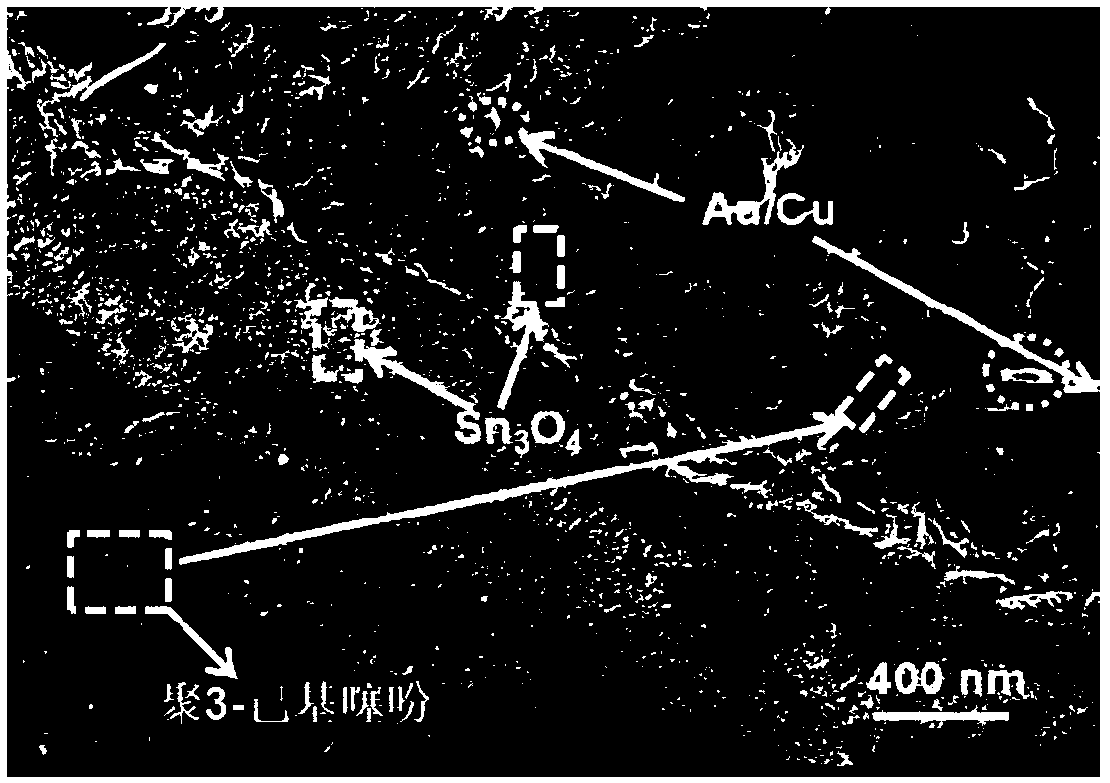Preparation method of poly(3-hexylthiophene) (P3HT)/metal-modified Sn3O4 nano composite photocatalytic material
A photocatalytic material, hexylthiophene technology, is applied in the field of preparation of nanocomposite photocatalytic materials, which can solve the problems of obvious hard agglomeration effect of samples, easy falling off of supported metals, complicated preparation process, etc. The effect of narrow diameter distribution and low preparation temperature
- Summary
- Abstract
- Description
- Claims
- Application Information
AI Technical Summary
Problems solved by technology
Method used
Image
Examples
Embodiment 1
[0031] 1) get 1mmol analytically pure stannous octoate (C 16 h 30 o 4 Sn) and 0.6mmol of acetic acid (CH 3 COOH) was fully dissolved in 2mL of absolute ethanol, then sequentially added 4mmol of sodium sorbate, 0.5mmol of phytic acid and 10mL of deionized water in an ice-salt bath of sodium chloride and crushed ice using a constant temperature magnetic stirring device Under the temperature condition of -20°C, the solution A is obtained by continuous magnetic stirring and mixing;
[0032] 2) Take 2 mmol of silver nitrate (AgNO 3 ), 7mmol of copper nitrate (Cu(NO 3 ) 2 ) and 0.1 mmol of acetic acid (CH 3 COOH) was fully dissolved in 7mL of deionized water. During the whole process, a constant temperature magnetic stirring device was used in an ice-salt bath of sodium chloride and crushed ice to continuously magnetically stir it at a temperature of -20°C to obtain solution B;
[0033] 3) Add solution B dropwise to solution A at a rate of 30 drops / min. The whole process is c...
Embodiment 2
[0039] 1) get 1mmol analytically pure stannous octoate (C 16 h 30 o 4 Sn) and 3 mmol of acetic acid (CH 3 COOH) was fully dissolved in 11mL of absolute ethanol, and then 12mmol of sodium sorbate, 3mmol of phytic acid and 17mL of deionized water were sequentially added in an ice-salt bath of sodium chloride and crushed ice using a constant temperature magnetic stirring device. Under the temperature condition of -15°C, carry out continuous magnetic stirring and mixing to obtain solution A;
[0040] 2) Take 1mmol of chloroauric acid (HAuCl 4 ), 6mmol of copper nitrate (Cu(NO 3 ) 2 ) and 5mmol of acetic acid (CH 3COOH) was fully dissolved in 12mL of deionized water, and a constant temperature magnetic stirring device was used to continuously magnetically stir it in an ice-salt bath of sodium chloride and crushed ice at a temperature of -15°C during the whole process to obtain solution B;
[0041] 3) Add solution B dropwise to solution A at a rate of 40 drops / min. The whole ...
Embodiment 3
[0048] 1) get 1mmol analytically pure stannous octoate (C 16 h 30 o 4 Sn) and 4.7mmol of acetic acid (CH 3 COOH) was fully dissolved in 17mL of absolute ethanol, then sequentially added 18mmol of sodium sorbate, 6mmol of phytic acid and 26mL of deionized water in an ice-salt bath of sodium chloride and crushed ice using a constant temperature magnetic stirring device Under the temperature condition of -10°C, carry out continuous magnetic stirring and mixing to obtain solution A;
[0049] 2) get 0.1mmol analytically pure chloroplatinic acid (H 2 PtCl 6 ), 1mmol of chloroauric acid (HAuCl 4 ), 7mmol of silver nitrate (AgNO 3 ) and 6mmol of acetic acid (CH 3 COOH) was fully dissolved in 15mL of deionized water, and a constant temperature magnetic stirring device was used to continuously magnetically stir it in an ice-salt bath of sodium chloride and crushed ice at a temperature of -10°C during the whole process to obtain solution B;
[0050] 3) Add solution B dropwise to ...
PUM
| Property | Measurement | Unit |
|---|---|---|
| length | aaaaa | aaaaa |
Abstract
Description
Claims
Application Information
 Login to View More
Login to View More - R&D
- Intellectual Property
- Life Sciences
- Materials
- Tech Scout
- Unparalleled Data Quality
- Higher Quality Content
- 60% Fewer Hallucinations
Browse by: Latest US Patents, China's latest patents, Technical Efficacy Thesaurus, Application Domain, Technology Topic, Popular Technical Reports.
© 2025 PatSnap. All rights reserved.Legal|Privacy policy|Modern Slavery Act Transparency Statement|Sitemap|About US| Contact US: help@patsnap.com

